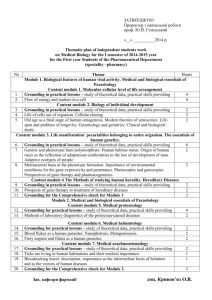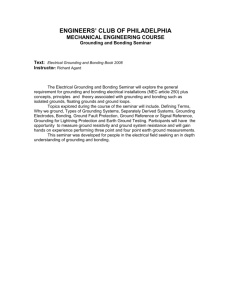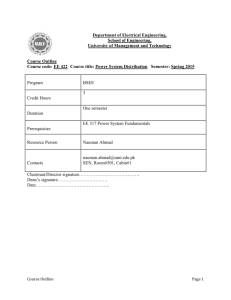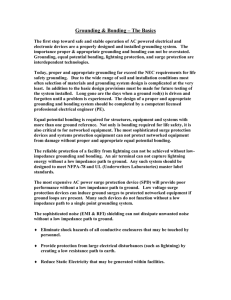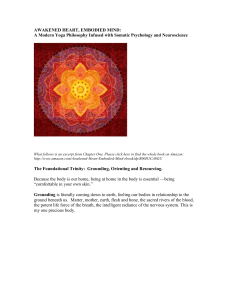Grounding Effect on Common Mode Interference of Coal Mine Inverter SUN Ji-ping
advertisement
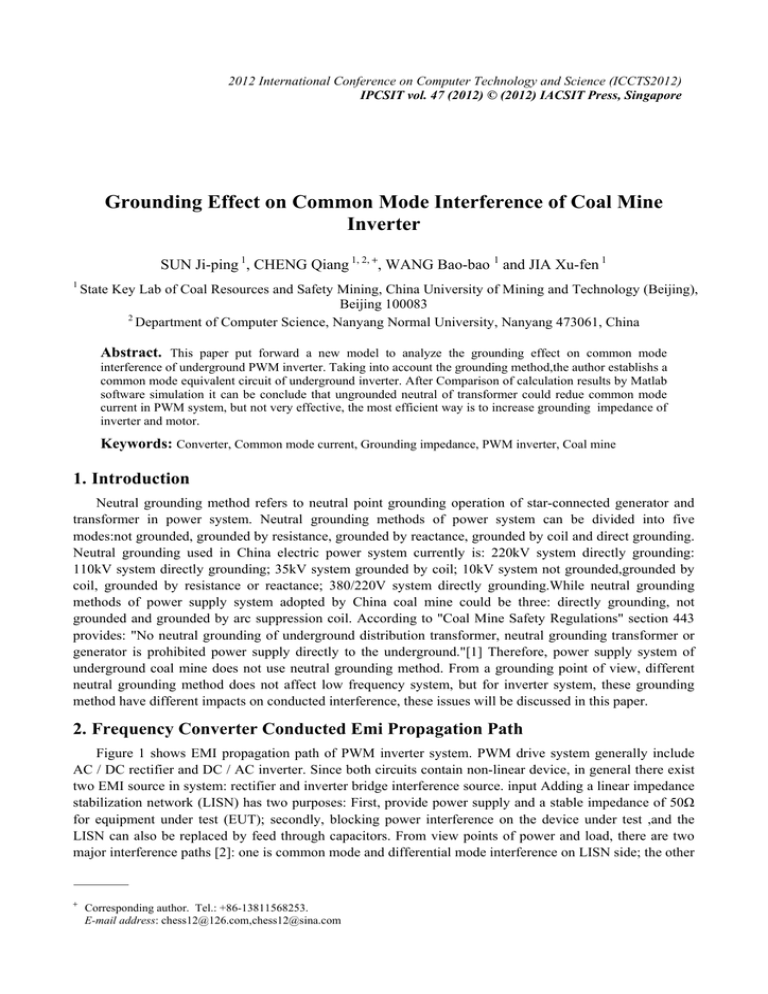
2012 International Conference on Computer Technology and Science (ICCTS2012) IPCSIT vol. 47 (2012) © (2012) IACSIT Press, Singapore Grounding Effect on Common Mode Interference of Coal Mine Inverter SUN Ji-ping 1, CHENG Qiang 1, 2, +, WANG Bao-bao 1 and JIA Xu-fen 1 1 State Key Lab of Coal Resources and Safety Mining, China University of Mining and Technology (Beijing), Beijing 100083 2 Department of Computer Science, Nanyang Normal University, Nanyang 473061, China Abstract. This paper put forward a new model to analyze the grounding effect on common mode interference of underground PWM inverter. Taking into account the grounding method,the author establishs a common mode equivalent circuit of underground inverter. After Comparison of calculation results by Matlab software simulation it can be conclude that ungrounded neutral of transformer could redue common mode current in PWM system, but not very effective, the most efficient way is to increase grounding impedance of inverter and motor. Keywords: Converter, Common mode current, Grounding impedance, PWM inverter, Coal mine 1. Introduction Neutral grounding method refers to neutral point grounding operation of star-connected generator and transformer in power system. Neutral grounding methods of power system can be divided into five modes:not grounded, grounded by resistance, grounded by reactance, grounded by coil and direct grounding. Neutral grounding used in China electric power system currently is: 220kV system directly grounding: 110kV system directly grounding; 35kV system grounded by coil; 10kV system not grounded,grounded by coil, grounded by resistance or reactance; 380/220V system directly grounding.While neutral grounding methods of power supply system adopted by China coal mine could be three: directly grounding, not grounded and grounded by arc suppression coil. According to "Coal Mine Safety Regulations" section 443 provides: "No neutral grounding of underground distribution transformer, neutral grounding transformer or generator is prohibited power supply directly to the underground."[1] Therefore, power supply system of underground coal mine does not use neutral grounding method. From a grounding point of view, different neutral grounding method does not affect low frequency system, but for inverter system, these grounding method have different impacts on conducted interference, these issues will be discussed in this paper. 2. Frequency Converter Conducted Emi Propagation Path Figure 1 shows EMI propagation path of PWM inverter system. PWM drive system generally include AC / DC rectifier and DC / AC inverter. Since both circuits contain non-linear device, in general there exist two EMI source in system: rectifier and inverter bridge interference source. input Adding a linear impedance stabilization network (LISN) has two purposes: First, provide power supply and a stable impedance of 50Ω for equipment under test (EUT); secondly, blocking power interference on the device under test ,and the LISN can also be replaced by feed through capacitors. From view points of power and load, there are two major interference paths [2]: one is common mode and differential mode interference on LISN side; the other + Corresponding author. Tel.: +86-13811568253. E-mail address: chess12@126.com,chess12@sina.com is common mode and differential mode interference on motor side, direction of interference propagation path shows as arrows in Figure 1. Fig. 1: PWM inverter system EMI propagation paths Motor drive systems often chose different grounding methods based on various requirements, such as compliance with safety standards, transient over-voltage limit to the ground, or interruption of program requirements etc. . Except for these, the impact of grounding configuration is aslo an important aspect of EMC performance.As mentioned above, noise voltage source and current source is subject to the impact of rectifier and inverter configuration. The following section focuses on general and idealized way of grounding configuration. Actually grounding method does not significantly change the interference source characteristics. Nevertheless, through changing high-frequency current flowing path ground configuration can indeed affect EMC performance. 3. Different Grounding Configurations As shown in Figure 2, the impedance between AC power neutral point and ground is denoted as ZNG. In addition, the impedance between inverter chassis and ground is noted as ZFG, and electrical resistance between motor frame and ground is defined as ZMG. Select a different impedance means a different grounding method. Fig. 2: Grounding method diagram In general switching function of inverter can be defined as si (i = a, b, c, u, v, w), then the voltage between DC-link midpoint (point O in Figure 2) and rectifiers can be expressed as ⎧vOa = ( 12 − sa )Vdc ⎪ 1 ⎨vOb = ( 2 − sb )Vdc ⎪v = ( 1 − s )V c dc ⎩ Oc 2 (1) Considering the symmetry of three-phase power, vON can be expressed by vaG + vbG + vcG vOa + vOb + vOc ia sLa + ib sLb + ic sLc 1 sa + sb + sc (2) + = +( − )Vdc 3 3 3 2 3 Here the first term means voltage on boost inductors with common mode current. The second is due to rectifier transistors switching on and off. vON = The inverter part of PWM converter can be expressed by the same method, vnO can be represented as vnO = iu sLu + iv sLv + iw sLw s + sv + s w 1 +( u − )Vdc 3 3 2 (3) So we can get a simplified high-frequency equivalent circuit of PWM inverter as shown in Figure 3, where ZNG represents impedance between AC power neutral point and ground, ZOG represents impedance between DC bus and ground, Lu represents motor winding inductance, ZMG represents impedance between motor and ground. Fig. 3: Equivalent circuit of PWM inverter system It is discussed in [3] all the grounding possibilities of low and medium voltage drive system. According to ZNG the grounding configurations can be divided into four methods: solidly grounding, low resistance grounding, high resistance grounding and ungrounded system. Due to its simplistic structure, solidly grounding method is commonly used. Ungrounded system does not become a standard on account of its relative uncertain capacitance between power lines and ground. Thus reference [4] suggested that the correct implementation of high resistance grounding system should be an industry regulation. In addition we have another grounding option of inserting a damping resistor ZMG between motor frame and ground [5]. Generally most motor chassis grounded solidly,grounding methods typically affects CM current flowing into ground. A simplified common-mode equivalent circuit shown in Figure 4 is to be discussed. Usually, it is necessary for measurement to insert LISN between power supply and equipment under test (EUT). In accordance with measurement standard requirements, LISN require solidly grounding. Consequently high-frequency EMI produced by EUT could be bypassed by LISN, thus ZNG has little effect on noise propagation path.So only ZFG and ZMG can play an important role on noise propagation paths. Fig. 4: Common mode equivalent circuit with ground parameters 4. Molding Results 80 60 60 40 40 20 20 Magnitude (dBμA) Magnitude (dBμA) 80 0 -20 0 -20 -40 -40 -60 -60 -80 -80 -100 -100 10 3 10 4 5 10 Frequency (Hz) 10 6 10 7 (a) ZNG,ZFG and ZMG all gounded or all equal to 200Ω 10 3 10 4 5 10 Frequency (Hz) 10 6 10 7 (b) Either of ZNG, ZFG and ZMG equal to 200Ω Fig. 5: Common-mode current in different grounding system As can be seen in Figure 5(a), grounding impedance (cyan lines) can indeed reduce common mode current, the difference is nearly 20dB at high frequency range. We can see in Figure 5(b), ZNG (green lines) has the most obvious effect, ZFG (red lines) has relatively worse results, while ZNG (blue lines) reduce the worst. When ZNG, ZFG and ZMG are all connected with damping resistor, the system have minimal commonmode currents. Therefore, the ungrounded neutral point of transformer secondary coil, which is equivalent to ZNG =200Ω,is beneficial for reducing common mode interference in PWM system, but not very effective, the most efficient way is to increase impedance of ZFG and ZMG. Nevertheless, motor frame must be grounded sloidly due to safety reasons. Recent years some scholars proposed installing a damping resistance in converter frame, and the frame must be grounded. Attention must be paid to avoid connecting resistance between chassis and ground, because this connection will increase risk of body electric shock, which is strictly prohibited by National mandatory safety standards. 5. Conclusion This paper put forward a new model to analyze the grounding effect on conducted EMI of a typical PWM motor drive. Based on a real object of industrial products, proposed extracting method of parasitic parameters on propagation path, established common mode EMI circuit model, proposed approximation method of high-frequency interference model to ensure the accuracy of high frequency prediction, and made quantitative experiment of conducted interference at power side and load side of PWM drive motors. The research ideas and practical calculation methods could be reference for prediction of conducted EMI system. In case motor frame is grounded solidly, common-mode current can flow through motor windings to motor frame, and then effectively into ground plane. Add a damping resistance in ZMG is a useful method of inhibiting motor-side high-frequency current [6]. Even the PWM rectifier is replaced by a diode rectifier, adding resistance in ZFG is also very effective, the noise generated by voltage source vrec can be mainly attenuated by ZFG. While the balance of ZMG and ZFG value should be considered, because the choice of a large ZFG will reduce the frequency impact of capacitor CY in inverter. 6. Acknowledgements This work is supported by the National Natural Science Foundation of China under Grant No. 50674093. The authors would very much like to thank colleagues of State Key Lab of Coal Resources and Safety Mining. 7. References [1] Meng Jin,Ma Weiming etc. “High Frequency Model of Conducted EMI for PWM Variable-speed Drive Systems”. Proceedings of the CSEE, 2008, 5,p. 141–143. [2] Skibinski G,Kerkman R,Schlegel D. “EMI Emissions of Modern PWM AC Drives”.IEEE Industry Applications Magazine,1999, 5(6):47–81. [3] H. Akagi and T. Doumoto. “An approach to eliminating high-frequency shaft voltage and leakage current from an inverter-driven motor”, IEEE Trans. Ind. Applicat., vol. 40, no. 4, 2004,7, p. 1162–1169. [4] Meng Jin,Ma Weiming. “Power converter EMI analysis including IGBT nonlinear switching transient model”.IEEE Trans.on Industrial Electronics, 2006, 54(5):1577–1583. [5] H. Akagi, T. Doumoto. “A passive EMI Filter for Preventing High-Frequency Leakage Current from Flowing through the Grounded Inverter Heat Sink of an Adjustable-Speed Motor Drive System”. IEEE Transactions on Industry Applications, Vol. 41, No 5, 2005, 9, p. 1215–1223. [6] H. Akagi and S. Tamura, “A passive EMI filter for eliminating both bearing current and ground leakage current from an inverter-driven motor,” IEEE Trans. Power Electron., vol. 21, no. 5, 2006,9, p. 1459–1469.


